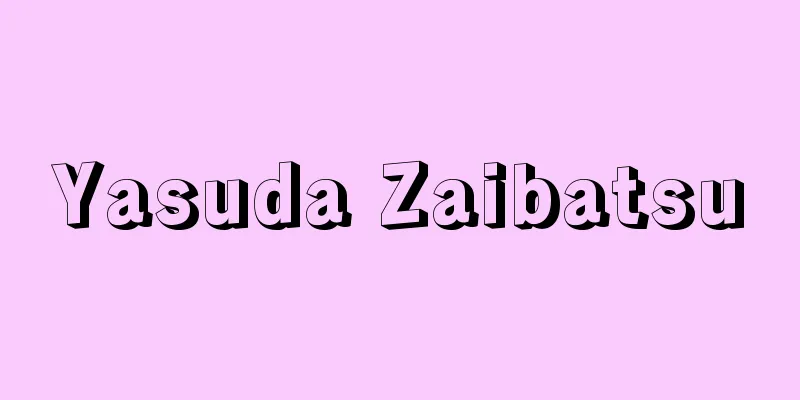Yasuda Zaibatsu

|
One of the four major zaibatsu before the Second World War, this financial conglomerate was built in one generation by Yasuda Zenjiro. It was founded in 1866 (Keio 2) as Yasuda Shoten, and succeeded in accumulating a large amount of capital during the monetary and financial turmoil of the late Edo period and the Meiji Restoration. He established the Third National Bank in 1876 (Meiji 9), the Yasuda Bank in 1880, and was appointed as a director of the Bank of Japan at its founding in 1882. After that, with the backing of the government's Bank of Japan, he merged or took control of many unstable banks, and further established life insurance and non-life insurance companies. Around the time of the Sino-Japanese War, he directly operated sulfur mines, spinning mills, warehouses, nail manufacturing, etc., and actively invested in railways, electricity, and port construction. However, unlike Mitsui and Mitsubishi, he did not train human resources such as university graduates, so direct operations other than finance were not successful, and from the end of the Meiji period, he was oriented toward development centered on finance. In order to manage the Yasuda family's assets rationally, an organization called Hozensha was established in 1887, which was reorganized in January 1912 (Meiji 45) as a limited partnership with capital of 10 million yen to serve as the management organization for the related banks and companies (renamed Yasuda Hozensha in 1925). After World War I, the related banks merged with Yasuda Bank at the center, and in 1923 (Taisho 12) Yasuda Bank was formed with a nominal capital of 150 million yen, which at one time had the greatest capital among the zaibatsu. However, without a significant industrial division, and with the Asano zaibatsu, its largest lender, falling into financial difficulties, the bank was unable to demonstrate its true strength as a zaibatsu during the recession in the early Showa period, and faced a crisis. At the end of World War II, Yasuda Hozensha had 20 direct-affiliated companies with a nominal capital of about 500 million yen, but after the zaibatsu were dissolved, these assets and human resources were inherited by the Fuji Bank group, the successor to Yasuda Bank.Fuji Bank was merged with Dai-Ichi Kangyo Bank and the Industrial Bank of Japan in 2002, and was integrated and reorganized into Mizuho Bank and Mizuho Corporate Bank. [Yui Tsunehiko] [Reference] | |Source: Shogakukan Encyclopedia Nipponica About Encyclopedia Nipponica Information | Legend |
|
第二次世界大戦前の四大財閥の一つで、安田善次郎(ぜんじろう)が一代で築いた金融中心の財閥。1866年(慶応2)設立の安田商店が母胎で、幕末・維新期の貨幣・金融の混乱期に多大の資本蓄積に成功した。1876年(明治9)に第三国立銀行を設立、1880年には安田銀行を設立、1882年創立期の日本銀行理事に就任、以後、政府日銀を背景に不安定だった多くの銀行を合併ないし支配下に置き、さらに生命保険および損害保険会社を設立した。日清(にっしん)戦争の前後には硫黄(いおう)鉱山、紡績、倉庫、製釘などを直営し、鉄道、電力、築港に活発に投資した。ただし、三井、三菱(みつびし)と違って学卒者などの人材を養成しなかったため、金融以外の直営事業は成功せず、明治末年からはもっぱら金融中心の発展が指向された。安田家の資産を合理的に運用するために、保善社という組織が1887年に設立されたが、これは1912年(明治45)1月には資本金1000万円の合名会社に改組されて、関係銀行・会社に対する管理機関となった(1925年に安田保善社と改称)。第一次世界大戦後には安田銀行を中心に関係銀行が合併し、1923年(大正12)には公称資本金1億5000万円の安田銀行が形成され、一時は財閥随一の資本力をもつに至った。しかし、有力な産業部門をもたず、最大の融資先の浅野財閥が経営難に陥ったため、昭和初年の不況期には財閥としての実力を発揮できず、危機に直面した。 第二次世界大戦終戦時の安田保善社の直系会社は20社、その公称資本金は約5億円であったが、財閥解体ののち、これらの資力と人材は、安田銀行の後身である富士銀行系の企業グループに継承された。なお、富士銀行は2002年(平成14)第一勧業銀行、日本興業銀行との分割および合併により、みずほ銀行、みずほコーポレート銀行に統合・再編されている。 [由井常彦] [参照項目] | |出典 小学館 日本大百科全書(ニッポニカ)日本大百科全書(ニッポニカ)について 情報 | 凡例 |
Recommend
Kinjiro Sekine
Shogi player. Born in Higashihoshubana, Chiba Pre...
Coal - Sekitan (English spelling)
It is a flammable rock-like organic material, mai...
Kusagaki Islands
Also known as Kusagaki Island, it is located on t...
Aikawa [town] - Aikawa
A town in Aiko District, in the northern part of K...
Hakuin - Hakuin
A Zen monk from the mid-Edo period. He is said to...
Genji firefly (English name) Luciola cruciata
Coleoptera, Lampyridae. With a body length of 12-1...
Isomorphous mixture
…This term was created before the development of ...
Itakura - Itakura
...They are often seen near human settlements thr...
Institute of Space and Astronautical Science
Please see the "Institute of Space and Astro...
Equisetum fluviatile (English spelling)
…[Masahiro Kato]. . . *Some of the terminology th...
Asansol (English spelling)
A mining and industrial city in the central state ...
Right to investigate national affairs
The power of a parliament to investigate national...
Benzanilide
Also known as N -benzoylaniline. Sublimable colorl...
Aquino, B. (English spelling) AquinoB
… [People Power Revolution] The presidential elec...
Oquilegia fusiformis (English spelling) Oquilegiafusiformis
… [Minoru Imajima]. … *Some of the terminology th...









